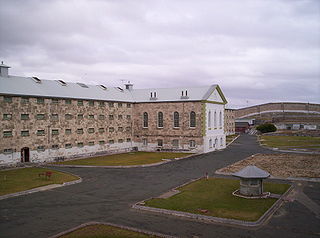Related Research Articles

The Youth Criminal Justice Act is a federal Canadian statute that covers the prosecution of youths for criminal offences.
A suspended sentence is a sentence on conviction for a criminal offence, the serving of which the court orders to be deferred in order to allow the defendant to perform a period of probation. If the defendant does not break the law during that period and fulfills the particular conditions of the probation, the sentence is usually considered fulfilled. If the defendant commits another offence or breaks the terms of probation, the court can order the sentence to be served, in addition to any sentence for the new offence.
In Canada and England and Wales, certain convicted persons may be designated as dangerous offenders and subject to a longer, or indefinite, term of imprisonment in order to protect the public. Dangerousness in law is a legal establishment of the risk that a person poses to cause harm. Other countries, including Denmark, Norway, and parts of the United States have similar provisions of law.
A habitual offender, repeat offender, or career criminal is a person convicted of a crime who was previously convicted of other crimes. Various state and jurisdictions may have laws targeting habitual offenders, and specifically providing for enhanced or exemplary punishments or other sanctions. They are designed to counter criminal recidivism by physical incapacitation via imprisonment.
Preventive detention is an imprisonment that is putatively justified for non-punitive purposes, most often to prevent further criminal acts.
In some common law nations, a recognizance is a conditional pledge of money undertaken by a person before a court which, if the person defaults, the person or their sureties will forfeit that sum. It is an obligation of record, entered into before a court or magistrate duly authorized, whereby the party bound acknowledges (recognizes) that they owe a personal debt to the state. A recognizance is subject to a "defeasance"; that is, the obligation will be avoided if person bound does some particular act, such as appearing in court on a particular day, or keeping the peace. In criminal cases the concept is used both as a form of bail when a person has been charged but not tried and also when a person has been found guilty at trial as an incentive not to commit further misconduct. The concept of a recognizance exists in Australia, Canada, Hong Kong, the Republic of Ireland, and the United States. Recognizances were frequently used by courts of quarter sessions, for example they make up more than 70% of surviving records for the Bedfordshire Quarter Sessions records.

The Rehabilitation of Offenders Act 1974 of the UK Parliament enables some criminal convictions to be ignored after a rehabilitation period. Its purpose is that people do not have a lifelong blot on their records because of a relatively minor offence in their past. The rehabilitation period is automatically determined by the sentence. After this period, if there has been no further conviction the conviction is "spent" and, with certain exceptions, need not be disclosed by the ex-offender in any context such as when applying for a job, obtaining insurance, or in civil proceedings. A conviction for the purposes of the ROA includes a conviction issued outside Great Britain and therefore foreign convictions are eligible to receive the protection of the ROA.
A discharge is a type of sentence imposed by a court whereby no punishment is imposed.
The Bolton 7 were a group of gay and bisexual men who were convicted on 12 January 1998 in the United Kingdom before Judge Michael Lever at Bolton Crown Court of the offences of gross indecency under the Sexual Offences Act 1956. Although gay sex was partially decriminalised by the Sexual Offences Act 1967, they were all convicted under section 13 of the 1956 Act because more than two men had sex together, which was still illegal. One of the participants was also six months under the statutory age of consent for male gay sex: at the time, such an age was set at 18, while the heterosexual and lesbian age of consent was instead set at 16.
The Bureau of Crime Statistics and Research (BOCSAR), also known as NSW Bureau of Crime Statistics and Research, is an agency of the Department of Communities and Justice responsible for research into crime and criminal justice and evaluation of the initiatives designed to reduce crime and reoffending in the state of New South Wales, Australia.

The Drug Court of New South Wales is an inferior court constituted as a court of record within the Australian court hierarchy with its jurisdiction limited to New South Wales, Australia. It is a specialist court that deals with criminal offences in which the defendant has an addiction to illicit drugs. The Court exercises both local and district court jurisdiction and has a similar status to the District Court of New South Wales.
The youth justice system in England and Wales comprises the organs and processes that are used to prosecute, convict and punish persons under 18 years of age who commit criminal offences. The principal aim of the youth justice system is to prevent offending by children and young persons.

The Criminal Justice and Immigration Act 2008 is an Act of the Parliament of the United Kingdom which makes significant changes in many areas of the criminal justice system in England and Wales and, to a lesser extent, in Scotland and Northern Ireland. In particular, it changes the law relating to custodial sentences and the early release of prisoners to reduce prison overcrowding, which reached crisis levels in 2008. It also reduces the right of prison officers to take industrial action, and changed the law on the deportation of foreign criminals. It received royal assent on 8 May 2008, but most of its provisions came into force on various later dates. Many sections came into force on 14 July 2008.
A conditional sentence is a non-custodial punishment for crime. It is one type of criminal sentencing used in Canada.

Punishment in Australia arises when an individual has been accused or convicted of breaking the law through the Australian criminal justice system. Australia uses prisons, as well as community corrections. When awaiting trial, prisoners may be kept in specialised remand centres or within other prisons.
Sentencing in England and Wales refers to a bench of magistrates or district judge in a magistrate's court or a judge in the Crown Court passing sentence on a person found guilty of a criminal offence. In deciding the sentence, the court will take into account a number of factors: the type of offence and how serious it is, the timing of any plea of guilty, the defendant's character and antecedents, including their criminal record and the defendant's personal circumstances such as their financial circumstances in the case of a fine being imposed.
An Order for Lifelong Restriction is a sentence that can be imposed by a judge of the High Court of Justiciary on serious violent and sexual offenders in Scotland. Such an order is an indeterminate sentence that will see the convict subject to indefinite imprisonment and supervision by electronic monitoring for the rest of their lives. An offender will only be released on licence where it is determined that the risks posed to the community can be correctly and safely managed.
Drug courts have been established in New South Wales, Queensland, South Australia, Victoria, and Western Australia. People appearing in Australian drug courts often fall outside the parameters for other pre-court diversion programs.
The New South Wales Department of Communities and Justice, a department of the Government of New South Wales, is responsible for the delivery of services to some of the most disadvantaged individuals, families and communities; and the administration and development of a just and equitable legal system of courts, tribunals, laws and other mechanisms that further the principles of justice in the state of New South Wales, Australia. It also provides services to children and young people, families, people who are homeless, people with a disability, their families and carers, women, and older people. The department is the lead agency of the Stronger Communities cluster of the New South Wales government.

Lifetime probation is reserved for relatively serious legal offenders. The ultimate purpose of lifetime probation is to examine whether offenders properly maintain good behavior as well as capability of patience under lifetime probation serving circumstance. An offender is required to abide by particular conditions for rest of their entire life in order to nurture superior social behaviour as a punishment for their criminal offence. Condition of probation orders contain supervision, electronic tagging, reporting to his or her probation or parole officer, as well as attending counselling. The essential component of lifetime probation carries the sense of being examined for well-being character and behaviour for life term period. Legislative framework regarding probation may vary depending on the country or the state within a certain country as well as the duration and condition of probational sentencing.
References
- 1 2 "Chapter 5: Reasons for high Indigenous imprisonment rates". Parliament of Australia. Retrieved 2019-05-12.
- 1 2 3 4 5 "Good Behaviour Bonds and Non-Conviction Orders: A report of the NSW Sentencing Council" (PDF). NSW Sentencing Council. September 2011.
- 1 2 "Good Behaviour Bonds Explained". www.findlaw.com.au. Retrieved 2019-05-12.
- ↑ "Legislative Council Hansard - 30 November 1999". Parliament of New South Wales.
- ↑ "Section 9 good behaviour bonds". www.judcom.nsw.gov.au. Retrieved 2019-05-12.
- ↑ "Sentencing adult offenders". Queensland Sentencing Advisory Council. May 2012. Retrieved 2019-05-12.
- 1 2 "Penalties and Sentences Act 1992".
- ↑ "Sentencing Act 1991" (PDF).
- ↑ Browne, Kylie (2014-04-03). "Possible outcomes and penalties". www.legalaid.vic.gov.au. Retrieved 2019-05-28.
- ↑ "29.4.4 - Good behaviour bond". www.judicialcollege.vic.edu.au. Retrieved 2019-05-31.
- ↑ "Sentencing Act 1995". Northern Territory Government.
- ↑ "Good behaviour order: supervised". Northern Territory Government. 2016-03-08. Retrieved 2019-05-12.
- ↑ "Good behaviour bonds". Legal Services Commission of South Australia.
- ↑ "Sentencing Act 2017" (PDF). www.legislation.sa.gov.au. Retrieved 2019-05-21.
- ↑ "Good behaviour bonds". Legal Services Commission of South Australia.
- ↑ "After conviction: what next?". Government of Western Australia: Department of Justice. Retrieved 2019-05-12.
- 1 2 "Sentencing Act 1995" (PDF). Department of Justice - Western Australia.
- ↑ "Sentencing". Hobart Community Legal Service. Retrieved 2019-05-21.
- 1 2 "Tasmanian Legislation Online - Sentencing Act 1997". www.legislation.tas.gov.au. Retrieved 2019-05-13.
- ↑ Justice, Department of (2015-01-07). "Glossary". www.sentencingcouncil.tas.gov.au. Retrieved 2019-05-31.
- ↑ Bartels, Lorana; Weatherburn, Don; Poynton, Suzanne (2014). "Good behaviour bonds and re-offending: The effect of bond length". Australian and New Zealand Journal of Criminology. 47 (1): 25–43. doi:10.1177/0004865813504769. ISSN 0004-8658. S2CID 155034384.
- 1 2 "Crimes (Sentencing) Act 2005" (PDF). ACT Legislation Register - Crimes (Sentencing) Act 2005.
- ↑ Larsen, Jacqueline Joudo (2014). "AIC Reports: Research and Public Policy Series - "Restorative justice in the Australian criminal system"" (PDF). Australian Government - Australian Institute of Criminology.
- ↑ "Police Accountability". Australian Law Reform Commission. Retrieved 2019-05-21.
- ↑ "19. Sentencing: Sentencing options". Australian Government: Australian Law Reform Commission. 2010-07-29. Retrieved 2019-05-12.
- ↑ "4513.0 - Criminal Courts, Australia, 2017-18". Australian Bureau of Statistics. 4 March 2024.
- ↑ "4513.0 - Criminal Courts, Australia, 2017-18". Australian Bureau of Statistics.
- 1 2 3 "Bonds, suspended sentences and reoffending: Does the length of the order matter?". Australian Institute of Criminology.
- 1 2 Community Relations Division, freecall 1800 685 449; Justice, NSW Department of. "Trends in conditional discharges". www.bocsar.nsw.gov.au. Retrieved 2019-05-31.
{{cite web}}: CS1 maint: numeric names: authors list (link)